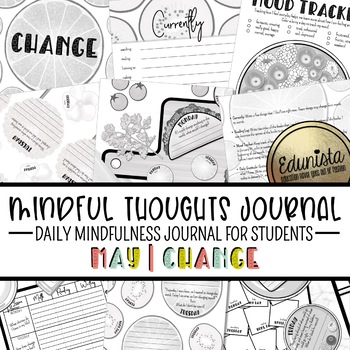Mindful Thoughts Journal: May/Change - Mindfulness / SEL Journal
- Zip
- Google Apps™

Also included in
- Are you looking for a way to give your students the support they need to develop a growth mindset, increase their mindfulness and build important social emotional skills? Look no further than the Mindful Thoughts Bundle! This amazing bundle includes engaging journals that are designed to spark yourPrice $69.97Original Price $96.00Save $26.03
Description
The Mindful Thoughts Journal is an essential tool for promoting a growth mindset and social emotional learning in the classroom. Each monthly journal is filled with daily mindfulness activities that are designed to help students develop a sense of calm, focus, and self-awareness. May’s journal includes a variety of exercises that focus on the topic of change. Students will think about different strategies for dealing with change.
The journal is perfect for use in the classroom, and includes downloadable images, Google Slides, and Google Drawings files, making it easy to use with Google Classroom, Seesaw, and other learning management systems. It's perfect for morning work or as conversation starters during morning meetings. The journal is designed to be flexible and can be used any time of the year.
The journal includes a variety of mindfulness activities for students, including a daily mood tracker, a reading log, and a daily gratitude page. The weekly spreads are designed to be printed back to back and bound in a three-ring binder, spiral binding, or with staples. The journal also includes a reflection page at the end of each month, allowing students to think back on the work they've done and develop an action plan for the future.
Included Mindfulness Activities for Students:
★ Directions Spread with Glossary:
There is a small glossary on the Directions spread to help the students complete their Mindful Thoughts Journals independently. We have created the Directions spread as editable allowing you to tweak the directions to best fit your classroom and students.
★ Currently:
Here students will write a few things that they currently enjoy doing. These things will likely change from month to month. The Currently page is a fun keepsake to look back at throughout the year to see how students' likes and dislikes change as they grow.
★ Reading Log:
Here students will write the titles of books that they have read during the month. Students will enjoy tracking their books on this fun themed page.
★ Mood Tracker:
Here students will keep track of how they feel each day. They will color in today’s number with the color that represents how they feel today or felt yesterday depending on when you have your students complete their journals. We recommend having your students work on their Mindful Thoughts Journals in the morning as they are beginning their day and complete the mood tracker for the day before. Keeping track of how your students feel will help them to better understand their emotions, how those emotions are triggered, and how their emotions can influence their day.
★ Daily Gratitude:
Gratitude is about focusing on the good things in our lives and being thankful for what we have. Here students will write one thing that they are grateful for each day. According to Harvard Health Publishing, studies have shown that the practice of expressing gratitude each day "is strongly and consistently associated with greater happiness. Gratitude helps people feel more positive emotions, relish good experiences, improve their health, deal with adversity, and build strong relationships." In a world where everyone from our students to our teachers and administration are feeling stress, teaching self-care practices with mindfulness activities for students like gratitude journals are not only encouraged but essential.
★ Weekly Spreads:
Each two-page spread is designed and laid out a little differently but they all have some of the same pieces. Each spread will have a spot to write and draw each day. We recommend that the students write their answers in complete sentences and expand on their writing. For example, they can explain why. Remember these questions are just to get the students started thinking.
Each day also has a doodle section. This section is meant to be a quick drawing for students to practice their sketching skills, and creative skills and practice expressing themselves. Some spreads have extra doodle sections. We like to have our students complete those sections when they have extra time after they have completed their other work.
★ Reflection:
When the journal is complete, students can think back on the work they’ve done focusing on the theme for this month and develop an action plan for the future.
The Mindful Thoughts Journal is an effective tool for promoting mindfulness, social emotional learning, and a growth mindset in the classroom, and we hope it will help your students as much as it has helped ours!






